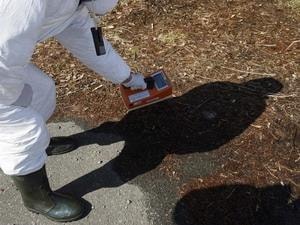Radiation at Fukushima 1 is 10 million times higher!
According to AFP, the nuclear accident at the Fukushima No. 1 plant in northern Japan has been pushed to an extremely high level of alarm when the concentration of radiation leaked in water from a reactor at the plant was 10 million times higher than normal.
According to officials from Tokyo Electric Power Company (TEPCO), the current radiation concentration measured here is 1,000 millisieverts/hour, an extremely dangerous level, forcing the emergency evacuation of workers operating turbines at the reactors.
“This is an extremely high level, likely due to water leaking from a reactor,” nuclear safety agency spokesman Hidehiko Nishiyama said.

A Greenpeace employee measures radiation levels.
in the soil near the Fukushima Daiichi plant. Source: Reuters
Scientists say that a concentration of 1,000 millisieverts can cause radiation exposure, with symptoms such as nausea and vomiting. Exposure of 100 millisieverts per year is considered the lowest level, and if this level increases, it means an increased risk of cancer.
Amid concerns about the possibility of fuel rods and pipes leaking, Japanese Chief Cabinet Secretary Yukio Edano admitted that progress in efforts to prevent a nuclear disaster at the plant was slow./.
Meanwhile, according to the New York Times, officials from the International Atomic Energy Agency (IAEA) have warned that the nuclear accident in Japan could continue for several more weeks, or even longer.
IAEA Director General Yukiya Amano said Japanese authorities are currently unsure how much water is needed to cover and cool the reactor core and fuel rods.
Emergency measures were deployed starting today to pump water into the overhead tanks, after several workers were burned while installing cables to repair the cooling system.
The incident has added to the pressure on TEPCO, as workers in their 20s and 30s have been forced to work with substandard protective equipment. And Edano has pledged to release public reports on the recovery process, amid growing suspicions of a cover-up.
The slow recovery efforts at the Fukushima No. 1 nuclear power plant have overshadowed all information about efforts to overcome the consequences of the 9.0-magnitude earthquake that caused tsunamis to hit northeastern Japan on March 11.
The fires and columns of white smoke rising from the plant have caused widespread concern across the Asia-Pacific region, not just Japan, about the most serious nuclear disaster since Chernobyl a quarter of a century ago.
According to TEPCO, radioactive clouds are currently spreading in the Pacific Ocean, and the concentration of radioactive iodine in seawater near the plant is measured to be 1,850 times higher than the allowable level (while a day earlier it was only 1,250 times higher).
Although Japan's nuclear safety agency has dismissed the direct threat to marine life and fishery safety, saying the radiation could be quickly dispersed by tides, several countries, including the European Union, Singapore, the United States and China, have also suspended imports of agricultural and dairy products from the Kanto region and the wider area surrounding Tokyo.
According to Vietnam+






